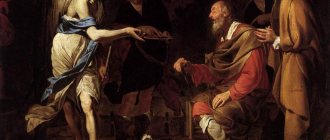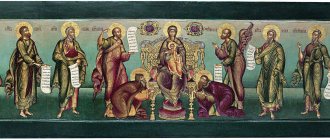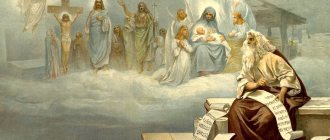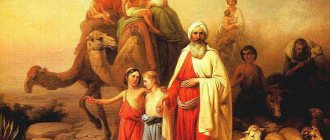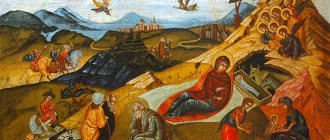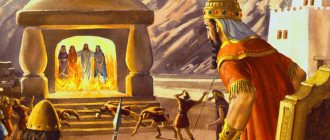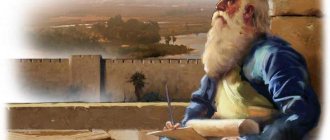The Book of Esther is one of the books of the Old Testament, it completes the cycle of historical books in the classical translation, and follows the book of Nehemiah.
The Book of Esther is written in Hebrew, but contains Aramaic and Persian phrases. Historians, theologians, and biblical scholars debate whether the Book of Esther is historically true or fiction. Some view the book of Esther as a pseudo-historical story—a parable. However, such an opinion is most likely incorrect, since the text contains many detailed descriptions and a lot of authentic Persian names.
Summary of the book of Esther.
King Ahasuerus (Artaxerxes/Xerxes) gathers the beauties of his empire to find a replacement for his queen Vashti, whom he himself stripped of her title. Among the beauties is Esther. Mordecai advises Esther not to reveal her Jewish heritage. Esther becomes queen of Persia.
Mordecai learns of the plot against King Ahasuerus and, through Esther, warns him of the danger.
Shortly after these events, the king appoints the Amalekite Haman as a high official and orders everyone to prostrate themselves before Haman. Mordecai refuses to bow. By this refusal, the Jew Mordecai does not show disrespect for the dignitary. Mordecai remains obedient to his God, who commanded
"to fight against the Amalekites from generation to generation."
Refusing to bow to the Amalekite was a matter of loyalty to God. This fact infuriated the dignitary. Having learned that Mordecai was a Jew, the dignitary became doubly angry. Haman decided to physically destroy not only Mordecai, but also all the Jews in the Persian empire. Following the instructions of the dignitary, King Achashverosh issued a decree on the extermination of the Jews.
After the royal decree was issued, Mordecai turned to Queen Esther and insisted that she had been chosen by God to save the Jewish people. Esther agreed to talk with the king, although this conversation could become a direct threat to her life.
One night, King Ahasuerus could not sleep and ordered the book of chronicles to be brought, which described the incident of how Mordecai warned the king about a conspiracy. It turned out that Mordecai still had not been thanked. The king decided to thank Mordecai and ordered the dignitary Haman to hold a ceremony honoring Mordecai.
Esther managed to expose the dignitary in the eyes of the king for his slander against the Jews. The king ordered Haman to be hanged on a stake that the dignitary had prepared for the execution of Mordecai. After the execution of the high official, Mordecai took over his post and received his house. Mordecai passed a decree on the right of the Jews to defend themselves and their property on the day of the appointed extermination. On this day, the Jews managed to destroy more than 75 thousand of their enemies. After these events, many Persians began to assimilate the Jewish faith.
The biblical book of Esther (Megillat Esther, “Scroll of Esther”) tells about a Jewish girl who, becoming the wife of the Persian king Ahasuerus, saved the Jews of his state from extermination.
Manuscripts, editions, dating
We are accustomed to a book having an author, and the author having a biography, which includes, at a minimum, the time and place of his life and work. But with most biblical texts everything is different: they are anonymous, the circumstances of their creation can be reconstructed at best approximately.
The earliest manuscript containing the Book of Esther (which is also the earliest complete manuscript of the Bible) is the medieval Codex Leningrad (1008). The text of the Book of Esther is also attested to by hundreds of other medieval texts. The differences between them are small and relate mainly to vocalization and accentuation.
No ancient manuscripts with the Hebrew text of the Book of Esther have survived. They were not found among those biblical manuscripts of the Roman and Hellenistic eras that were found in the caves of Qumran near the Dead Sea. All the books of the Hebrew Bible are represented there, and only the book of Esther does not survive in a single fragment. This, apparently, is not just an accident: there is no Purim holiday in the calendar of the Qumran community. Why the Qumranites did not celebrate Purim and read the book of Esther, we do not know.
One of the guidelines for dating a book can be the persons and realities mentioned in it. The Persian king's name is Achashverosh, a Hebrew rendering of the Persian name Khshayarsha. This was the name of the fourth representative of the Achaemenid dynasty. Ancient authors convey his name as. Obviously, the book of Esther was not written before the reign of Xerxes (486–465 BC). But, of course, it could well have been written later, even much later.
Another guide may be the date of the Greek translation of the book included in the Septuagint. The oldest manuscripts of the Septuagint are the Vatican (IV century AD), Sinaiticus (IV century AD) and Alexandrian (V century AD) codes. The Septuagint developed gradually starting from the 3rd century BC. e. At the end of the Greek translation of the Book of Esther there is a note stating that it was brought to Alexandria in the fourth year of the reigns of Ptolemy and Cleopatra. But we do not know which Ptolemy and which Cleopatra we are talking about: this was the name of many kings and queens of Hellenistic Egypt. The last of the Ptolemies ruled in 44–30 BC. e. Therefore, we will not be mistaken if we say that by the 40s of the 1st century BC. e. a translation of the Book of Esther probably already existed. The Hebrew text was obviously created earlier.
Along with the standard Greek text of the book of Esther, included in the Septuagint, there is another Greek text (the so-called Alpha Text), preserved in only four medieval manuscripts (X-XIII centuries). Some scholars consider it a reworking of the same translation, others think that the Alpha Text is based on a different translation, reflecting a different edition of the Hebrew original, and then partially corrected and supplemented taking into account the Septuagint. The second point of view, which became popular in the last third of the 20th century, looks convincing.
The Greek text of the book of Esther (in both editions) includes several large additions that are not found in the Hebrew. Mordechai's prophetic dream is added at the beginning of the book, and its interpretation is added at the end. In addition, both royal decrees, the prayers of Mordechai and Esther, and a description of Esther’s arrival to Ahasuerus are inserted into the narrative. Some additions (prophetic dreams, prayers) enhance the religious aspect of the book. The sentimental scene of Esther's entrance modifies the portrait of the main character, painting her as more delicate and timid. The Tsar's decrees emphasize (as "authentic documents") the pseudo-historical genre of storytelling. Judging by the style, many of the additions were translated into Greek from a Hebrew or Aramaic original, now lost. But the royal decrees, distinguished by their elegant language, were written immediately in Greek.
Josephus Flavius, writing at the end of the 1st century AD. e. "Antiquities of the Jews", already used the Greek translation of the book of Esther, which included most of the additions. Only Mordechai’s prophetic dream and its interpretation are not reflected in Josephus: perhaps they were not in the text known to him. At the same time, he adds in his retelling some details that are not found either in the main text of the book or in the additions of the Septuagint.
Jerome, translating the Bible from Hebrew into Latin, also translated the additions to the book of Esther (from Greek), but placed them after the main text of the book, as a kind of appendix. In many modern translations of the Bible, these additions are also printed, although Protestant churches consider them apocryphal (they do not recognize their canonical status).
Did this all really happen?
“It was in the time of Achashverosh...” - this is how the book begins. King Ahasuerus, aka Xerxes, really existed; but did everything that is described in the text exist in his time? Did he have a rebellious wife, Vashti? Did he then marry the Jewish woman Esther? Did Haman and Mordechai exist? Was a decree issued about the beating of Jews, and then another decree about the Jews beating their enemies? No other sources report anything like this. But the silence of sources is not a very strong argument, since there are relatively few of them. In such a situation, the question of the reliability of the narrative turns into a question of its credibility. Does the author manage to convince us that he is describing a real story?
On the one hand, the text mentions the realities of the Persian state: for example, seven nobles-advisers (1:14; cf.: Herodotus, 3.84), a communication system through horse-couriers (3:13; 8:10; cf.: Herodotus, 8.98), the custom of recording services rendered to the king (2:23; 6:8; cf. Herodotus, 8.85, 90), royal horses with a diadem (6:8; found on reliefs from Persepolis), etc. The impression of authenticity is also created Persian borrowings: words meaning “law”, “decree”, “copy”, “treasury”, “relatives”, “satraps”, etc. Many proper names can more or less likely also be considered Iranian (for example, Parshandata - that’s the name of Haman’s eldest son in the book). The name Mordecai is derived from the Babylonian god Marduk; similar names appear in Persian documents.
On the other hand, some details of the story are clearly implausible. This is an exaggerated description of the feast of Ahasuerus, which supposedly lasted 180 days (1:4), and a funny decree that “every man should be master in his own house” (1:22: reaction to Vashti’s disobedience), and the principle of the irrevocability of any royal decree (8:8). The book states (2:6) that Mordecai was deported to Babylonia along with King Jeconiah of Judah (597 BC), more than a hundred years before the reign of Xerxes (486 BC). e.).
Darius I and his successor Xerxes (left). Relief fragment of the treasury in Persepolis. . Beginning 5th century BC e. . Tehran. National Archaeological Museum of Iran
But the matter is not only in individual inaccuracies, exaggerations and chronological inconsistencies. The very plot of the book is questionable. According to Herodotus (3.84), girls from noble Persian families became Persian queens, so the Jewish Esther had very little chance in this sense. By the way, Herodotus mentions the wife of Xerxes: her name was Amestris (7.114, 9.112), not Vashti or Esther.
Ethnic conflict between Jews and other inhabitants of the empire is not impossible. Probably, the tsarist administration could intervene in such conflicts, play on the contradictions between communities, supporting one side or the other. But to officially organize a massacre throughout the empire and in the palace itself would be a rather extravagant step. Of course, people vested with unlimited power sometimes make unmotivated and strange decisions. If you wish, you can insist that the book of Esther is based on real events, albeit embellished by the narrator. Such a thesis can neither be refuted nor confirmed until archaeologists discover the original texts of both decrees of Ahasuerus or some other documents relating to the events described in the book. Now, in any case, scholars are not inclined to consider the narrative of the book of Esther as historically accurate.
Etymology of the name of the holiday
As explained in Esther 3:7 and 9:24, the name "Purim" comes from the word "pur" (lot), because Haman cast lots to choose the day of the slaughter. The word "pur" is found only in the book of Esther. This word is not Hebrew, but Aramaic; it goes back to the Akkadian “pur” (in Hebrew “lot” would be “goral”). The explanation of the name "Purim" given in the book does not satisfy many scholars. Various hypotheses have been expressed about the ancient origins of the holiday and the true etymology of its name. For example, Purim was associated with the Zoroastrian Farvardigan, a ten-day period of remembrance of the dead that occurs at the end of the year (that is, in early spring). When the holiday was borrowed by Jews, its name could have been turned into “Purim.” The association with Aramaic "pur" then represents a folk etymology.
Feast, holiday, carnival
The book begins with a royal feast and ends with a Jewish holiday. Feasts and holidays form the axis on which the narrative episodes are strung. The word “feast” appears nearly as many times in the book of Esther as in all other books of the Hebrew Bible combined. During the royal feasts, the fates of heroes (Vashti, Haman, Mordechai) and even the entire Jewish people are decided.
Perhaps the key role of the feast reflects the fact that the book of Esther was intended to be read during Purim. It expresses in narrative form the same meaning contained in holiday customs. Since ancient times, Purim has been characterized by unbridled fun: already in the Talmudic treatise Megillah (7b) there is a famous injunction to get drunk on Purim to such an extent as to confuse the phrases “blessed is Mordechai” and “cursed is Haman.” The blurring of boundaries and the mixing of opposites is typical for carnival-type celebrations. In medieval and modern Jewish communities, men could dress in women's clothing and women in men's clothing during Purim; they chose a buffoonish rabbi who delivered a mock sermon; the boys sat in the synagogue in places intended for respectable old people, etc. The motifs of the carnival can also be traced in the biblical book of Esther: here the strong and the weak, Haman and Mordechai, the Jews and their persecutors change places. Hence the comic moments (for example, the scene during Haman’s last feast with Ahasuerus and Esther, when Haman throws himself at Esther’s feet, begging for mercy, and Ahasuerus interprets this gesture as harassment).
Silence about the sacred
The Book of Esther (its Hebrew text, not the Greek) differs sharply from most biblical books in that it says nothing about G‑d, angels, prayer, the Temple, Jerusalem, or the chosenness of Israel. Only Haman mentions the Torah and the commandments in his report to Ahasuerus: “their laws are not the same as those of all nations.” In short, the book is almost completely devoid of direct religious discourse. Perhaps the only exception is the fast of Esther, which, at her request, all Jews in Susa join.
The silence about the sacred seemed strange to the ancient readers of the book. Perhaps that is why some Talmudic sages up to the 3rd or 4th century AD. e. they doubted whether to attribute it to the Holy Scriptures (Megillah, 7a; Sanhedrin, 100a).
Both Greek translations, and especially the additions contained in the Septuagint, correct this “shortcoming” of the Hebrew text. In the Greek book of Esther, G‑d is mentioned more than fifty times. The climax of the story (when Esther appears to Achashverosh without an invitation) is preceded here not only by fasting, but also by two prayers - Mordechai and Esther herself. The authors of the additions try to interpret the not entirely clear or not entirely orthodox actions of the main characters so that the reader does not have doubts about their piety. We learn that Mordechai refused to prostrate himself before Haman not out of pride, but out of religious reasons. Esther can hardly tolerate her pagan husband, finds joy only in G‑d and keeps kosher.
The reasons for the apparent "secularism" of the Hebrew text of the Book of Esther remain a matter of debate among commentators. We will return to this issue below. In any case, the silence about the sacred in the Hebrew text of the book of Esther does not indicate a secular or skeptical worldview of the author. The sacred is not spoken about directly, but it is implied. The lack of direct references is compensated by references to cross-cutting themes of the biblical tradition. Let's look at some of these allusions.
Scroll of Esther.
Fragment. Holland. XVIII century. NY. Library of the Jewish Theological Seminary The hero who does not show promise turns out to be the chosen one.
The stories of the rise of a humiliated, disadvantaged, marginal character are important in the Bible. The foremother of the Jewish people turns out to be a barren old woman. The younger of the two twins receives the birthright. The younger brother, hated by his brothers and sold into slavery by them, becomes their master and savior. The giant hero, armed to the teeth, is defeated by a boy with a sling, the youngest of the brothers. Then he becomes the king, the founder of the dynasty. The woman becomes the head of the army and wins. A woman uses cunning to kill an enemy commander.
The plot of the book of Esther also belongs to this type, where a woman brings salvation to the people, and she is also an orphan, that is, a character doubly marginal by the standards of a patriarchal society.
Of course, chosen heroes who do not show promise are often found in world folklore: myth, epic, and especially fairy tales. Let's remember Cinderella or Ivan the Fool. In the fairy tales of the peoples of the world we find many stories about poor orphans, younger brothers and persecuted stepdaughters. But the preference given to this type of hero by the biblical tradition is probably also due to the peculiarities of Jewish history. Wars, deportations, dispersal to different countries, the oppression of successive empires forced Jews to identify themselves with the weak and persecuted. The thought that such a hero was chosen by G‑d and had a great future was a source of consolation for them.
Rogue Hero
Disadvantaged and marginalized characters can achieve success in different ways. Sometimes their rise is entirely due to the higher power that patronizes them. For example, this is the case with barren Sarah, Rebecca or Rachel: only G‑d can send them a child. But it also happens that the hero himself is endowed with the ability to find a way out of a difficult situation. This is a rogue hero, or trickster. Often he is helped by a deity (as, for example, in the story of Jacob), but sometimes the help of a deity is practically not mentioned. The trickster uses cunning against an enemy who is superior to him in brute force. Trickster stories often contain sexual themes. Tricksters are often women. For example, in Judges 4-5, Yael lures a Canaanite commander into his tent, puts him to sleep, and then kills him. Here sexual motives sound muffled. They are more clear in the book of Judith, which is not included in the Hebrew Bible, but has come down to us as part of the Septuagint.
Esther is endowed with the traits of a trickster. Once in the palace, she cleverly hides her Jewish identity. Like Yaeli and Judith, she knows how to charm, lull one's guard, and wait for the right moment. She acts, like many other tricksters, at her own peril and risk. At the same time, she and Mordechai are constantly helped by a happy accident. By chance, the king could not sleep just the night before Haman’s planned execution of Mordechai and came across in a memorial book an entry about the conspiracy uncovered by Mordechai. By chance, it seemed to the king that Haman was encroaching on Esther when he begged her for mercy. Coincidence, luck is a form of manifestation of divine patronage, suitable for a picaresque plot and not requiring explicit mention of the deity every time. Perhaps this partly explains the silence about the sacred in the book of Esther.
Jew at the court of a pagan king
The Bible repeatedly contains a story about a Jew who rose to prominence at the court of a pagan king. Joseph made a similar career at the court of Pharaoh, Daniel at the court of Nebuchadnezzar, and Mordechai at the court of Ahasuerus. In essence, this is also a hero who does not show promise (due to his origin), but achieves success.
A special version of this plot is when the hero owes his career to a woman. In the book of Genesis (chapter 12), Abraham, fleeing famine, moves to Egypt with his wife Sarah. But in front of the Egyptians they pretend that they are brother and sister, and not husband and wife. Sarah ends up in Pharaoh's harem, and Abraham, her "brother" and therefore the king's brother-in-law, receives rich gifts. Both Sarah and Esther become wives of a foreign king due to their unusual beauty. Sarah hides that she is Abraham's wife, and Esther hides that she is a Jew and a relative of Mordechai. The story of the forefather and his wife pretending to be brother and sister appears twice more in the book of Genesis (chapters 20 and 26). It is not possible here to make a detailed comparison of all three episodes with each other and with the book of Esther. Let us simply note the very fact of the repeatability of the motif, which probably indicates its importance for the Hebrew tradition.
Persecution and Deliverance
The salvation of the Jewish community from persecution is a theme that unites the book of Esther with the legend of the exodus from Egypt. In both cases, Jews are presented as a disloyal minority to the authorities. Pharaoh thinks that “if war happens, he (the Jewish people) will unite with our enemies, fight with us and leave our country” (Ex. 1:10). Haman explains to Achashverosh that “their (the Jews’) laws are not the same as those of all nations, and they do not obey the king’s laws” (Esther 3:8). In both the Exodus and Esther stories, the Jewish community is led by a leader associated with the royal court: Moses was raised by Pharaoh's daughter, Mordechai is the cousin and adoptive father of the king's wife. In both cases, a holiday is established in memory of the deliverance of Jews from danger: Easter and Purim. Both holidays fall in the spring and can probably be associated with ancient ideas about the spring revival of nature, the annual victory of the forces of life over the forces of death. The massacre of the Jews against their enemies, described in the last chapters of the book of Esther, is partly corresponded to the Egyptian plagues in the narrative of the exodus. True, with an important difference: in the book of Exodus, God himself punishes the Egyptians, and the punishments there are of a supernatural nature.
Holy war and spell
The decree of Achashverosh allows Jews to destroy their enemies along with women and children, and to plunder their property (8:11). But the Jews, as the text emphasizes three times, limited themselves to killings only and refrained from robbery (9:10, 15, 16). Why is this so important? Perhaps the refusal to plunder is an allusion to the rules of the holy war, which, according to biblical tradition, was waged by the ancestors of the Jews with the inhabitants of Canaan in order to take possession of the promised land. When a city was captured, it had to be “exorcised” or “dedicated” (herem). This meant the total destruction of all inhabitants, including women and children (Deut. 2:34, 3:6, 20:16-17; Josh. 6:21). Livestock and property are sometimes given up for plunder (Deut. 2:35, 3:7; Josh. 8:2, 27, 11:14), but in other cases they are also subject to destruction: livestock is killed with the sword, and everything else is burned (Deut. 13:16-18; Josh. 6:17-19, 21, 24; 1 Samuel 15:3). At the same time, everything that was cursed was considered dedicated to G‑d, as if sacrificed to him (Josh. 6:17, cf. Mic. 4:13; 1 Kings, 20:42). The appropriation of the accursed made the blasphemer himself accursed (Deut. 7:25-26) and the entire army (Josh. 6:18, 7:12; 1 Kings 20:42). In Josh. 7:15, 25 such a person is burned with all his family and property. Even leaving part of the livestock alive for sacrifice is a sin (1 Samuel 15:14-26). The massacre of the Jews against their enemies in Esther 9 can be understood as analogous to a holy war. The spell falls on the enemy's property, so it is simply dangerous to appropriate it.
The custom of the spell has parallels among various peoples (Romans of the archaic era, Gauls, ancient Germans). Its existence in the countries of the ancient Levant is confirmed by the inscription of Mesha, king of Moab (second half of the 9th century BC), which says, in particular: “said to me: “Go and take Nebo from Israel.” I set out at night, attacked the city and fought from sunrise until noon. Having captured it, I killed everyone - seven thousand men, natives and immigrants, with their wives and concubines: I dedicated them to Ashtar-Kemosh. The last phrase uses a verb that has the same root as the Hebrew “herem.” How often the spell was practiced, we do not.
Those biblical texts where herem plays the most important role (primarily the book of Joshua) do not seem to describe real events. The Canaanite cities, subjected to total destruction in the pages of the Bible, mostly either did not exist in the corresponding period or were not destroyed. The pogrom of the persecutors in the book of Esther, like the holy war with the pagans in the story of the conquest of Canaan, is most likely a fantasy projected into the legendary past. These texts are dictated by ressentiment, that is, the dream of getting up from your knees and taking revenge on the offenders.
The mechanism of collective violence
Paradoxically, the vengeful fantasy in the book of Esther reveals some truth about violence. According to R. Girard, the main threat to the human collective is the endless violence of all against all. To maintain unity, the collective unconsciously focuses violence on one victim - the scapegoat. The choice of scapegoat is arbitrary, but usually this role falls to those who stand out from the crowd (outsiders, cripples, etc.). In the next stage, the violence is transferred from the human to the animal, which replaces the scapegoat. In the course of such a double substitution (of real numerous personal enemies - a common scapegoat, and then of a scapegoat - a sacrificial animal), violence takes on the character of a ritual, and society is temporarily stabilized.
In the book of Esther, the role of scapegoat was initially intended to be “one nation, scattered among other nations, but separate” and having different laws from all nations. This makes him suitable for the role of scapegoat. We remember that the royal decree on pogrom, and here an analogy with the inexorable collective violence in Girard’s concept suggests itself. It is impossible to stop violence, but you can deceive him and slip him another victim. This is exactly what happens when the second decree turns violence against the former persecutors, their wives and children. In this case, violence takes on a form similar to herem, that is, it approaches a ritual sacrifice.
Formally, both royal decrees had legal force: the command to the pagans to kill the Jews, and the command to the Jews to kill their persecutors. But the officials of the royal administration correctly heard the signal and sided with the Jews, “because they were seized with fear of Mordechai” (9:3). Moreover, “many Gentiles converted to Judaism because they were afraid of the Jews” (8:16). The second decree appointed new enemies of the people. The reprisal against them is carried out with the support of the authorities and “many pagans.” But the consensus with which the book ends is fragile. Fear of power is a double-edged sword; such loyalty always threatens to turn into hatred and pogrom.
COMMENTS
